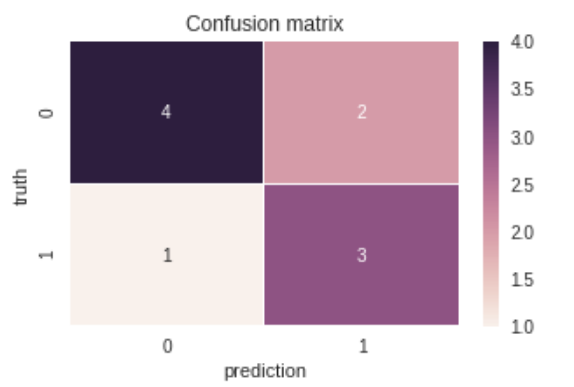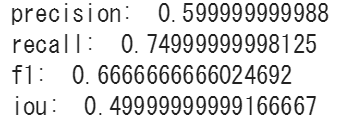Library
import numpy as np
import matplotlib.pyplot as plt
%matplotlib inline
import seaborn as sns
from sklearn.metrics import confusion_matrix, f1_score,recall_score, precision_score
from sklearn.metrics import recall_score, precision_score
Data
y_true = np.array([0, 0, 0, 0, 1, 1, 1, 0, 1, 0])
y_pred = np.array([0, 0, 0, 0, 1, 1, 1, 1, 0, 1])
plt.figure(figsize = (5, 3))
sns.heatmap(confusion_matrix(y_true, y_pred), annot=True, linewidths=0.1,
linecolor='white')
plt.title('Confusion matrix')
plt.xlabel('prediction')
plt.ylabel('truth')
plt.show()
Sample code
def precision(y_true, y_pred):
true_positives = np.sum(np.round(np.clip(y_true * y_pred, 0, 1)))
predicted_positives = np.sum(np.round(np.clip(y_pred, 0, 1)))
precision = true_positives / (predicted_positives + 1e-10)
return precision
def recall(y_true, y_pred):
true_positives = np.sum(np.round(np.clip(y_true * y_pred, 0, 1)))
possible_positives = np.sum(np.round(np.clip(y_true, 0, 1)))
recall = true_positives / (possible_positives + 1e-10)
return recall
def f1(y_true, y_pred):
pr = precision(y_true, y_pred)
re = recall(y_true, y_pred)
return 2*((pr * re) / (pr + re +1e-10))
def iou(y_true, y_pred):
true_positives = np.sum(np.round(np.clip(y_true * y_pred, 0, 1)))
false_positives = np.sum(np.round(np.clip((1-y_true) * y_pred, 0, 1)))
false_negatives = np.sum(np.round(np.clip(y_true * (1-y_pred), 0, 1)))
return true_positives / (true_positives + false_positives +
false_negatives + 1e-10)
print ('precision: ', precision(y_true, y_pred))
print ('recall: ', recall(y_true, y_pred))
print ('f1: ', f1(y_true, y_pred))
print ('iou: ', iou(y_true, y_pred))
sklearn
print ('precision: ', precision_score(y_true, y_pred))
print ('recall: ', recall_score(y_true, y_pred))
print ('f1: ', f1_score(y_true, y_pred))
Focal loss
def iou_loss(y_true, y_pred):
true_positives = K.sum(K.clip(y_true * y_pred, 0, 1))
false_positives = K.sum(K.clip((1-y_true) * y_pred, 0, 1))
false_negatives = K.sum(K.clip(y_true * (1-y_pred), 0, 1))
io = true_positives / (true_positives + false_positives +
false_negatives + K.epsilon())
return 1-io
def focal_loss(gamma=2., alpha=.25):
def focal_loss_fixed(y_true, y_pred):
pt_1 = tf.where(tf.equal(y_true, 1), y_pred, tf.ones_like(y_pred))
pt_0 = tf.where(tf.equal(y_true, 0), y_pred, tf.zeros_like(y_pred))
ret = -K.sum(alpha * K.pow(1. - pt_1, gamma) *
K.log(pt_1)) -K.sum((1-alpha) * K.pow( pt_0, gamma) *
K.log(1. - pt_0))
return ret
return focal_loss_fixed
#model.compile(loss=[loss_iou], optimizer='adam', metrics=['accuracy', iou])
model.compile(loss=[focal_loss(gamma=2,alpha=0.6)], optimizer='adam', metrics=['accuracy', iou])


